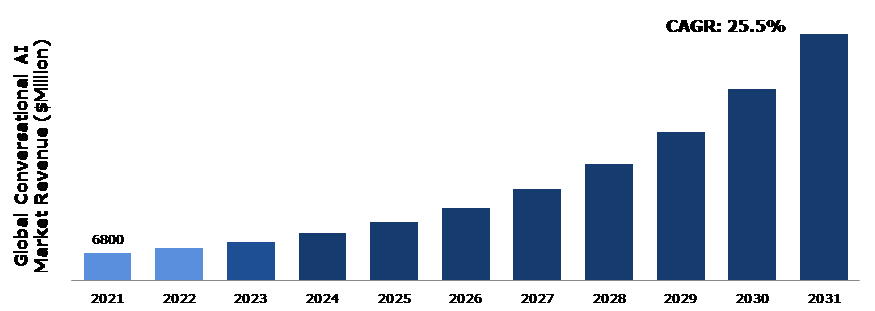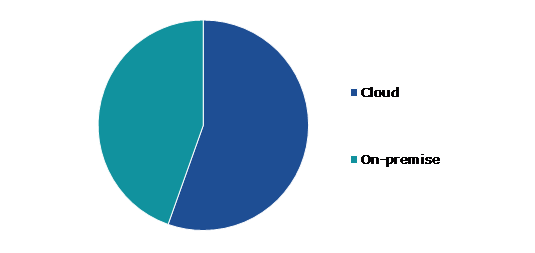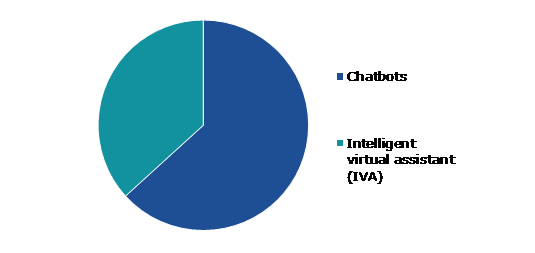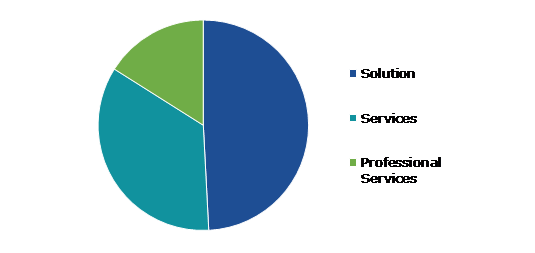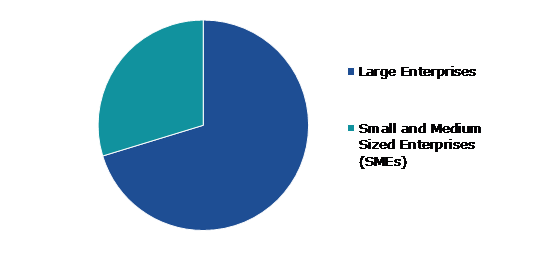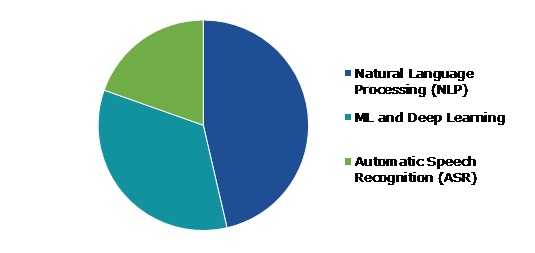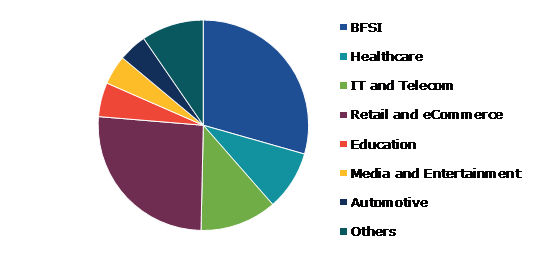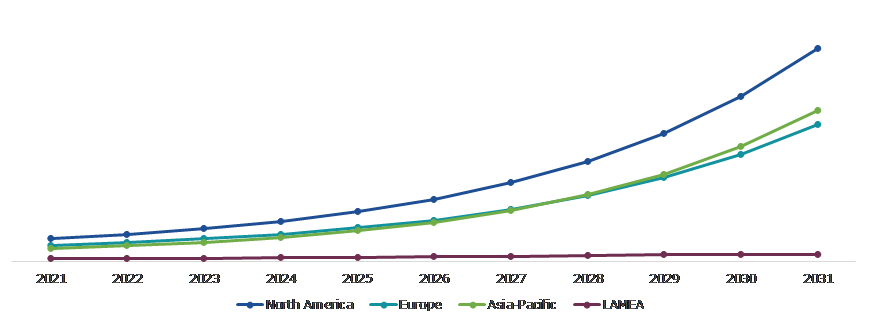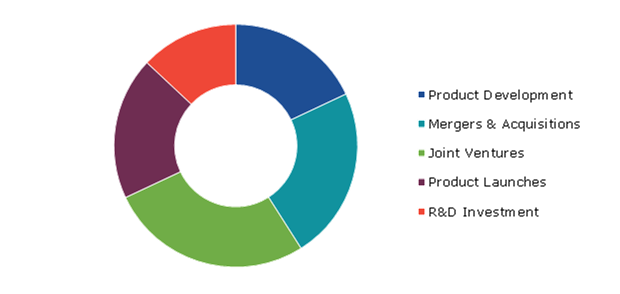Conversational AI Market Report
RA08249
Conversational AI Market by Deployment (Cloud and On-premise), Type [Chatbots and Intelligent Virtual Assistant (IVA)], Component (Solution, Services, and Professional Services), Organization Size [Large Enterprises and Small and Medium Sized Enterprises (SMEs)], Technology [Natural Language Processing (NLP), ML and Deep Learning, and Automatic Speech Recognition (ASR)], End-user (BFSI, Healthcare, IT and Telecom, Retail and eCommerce, Education, Media and Entertainment, Automotive, and Others), and Regional Analysis (North America, Europe, Asia-Pacific, and LAMEA): Global Opportunity Analysis and Industry Forecast, 2022–2031
Global Conversational AI Market Analysis
The Global Conversational AI Market Size is predicted to be valued at $62,114.7 million by 2031, surging from $6,800.0 million in 2021, at a noteworthy CAGR of 25.5%.
Global Conversational AI Market Synopsis
The numerous benefits offered by conversational AI such as contactless customer service, increased customer satisfaction, and consistent customer support are some of the major factors driving the adoption of conversational AI during the forecast period. AI-powered customer support services offer deeper insights and increase customer experience. This in turn increases customer retention rates and revenue generation as well as improves brand image. Moreover, conversational AI enhances the customer support consistency of the organization by reducing the number of repetitious tasks customer support agents do on daily basis.
The challenges with chatbots such as limited functionality and high cost of installation may restrain the conversational AI market growth over the forecast period. Chatbots cannot respond efficiently to multi-part questions. Thus, customers often do not get a solution to their queries.
Conversational AI technology is adopted across a broad range of use cases and sectors. The wider applicability of conversational AI such as chatbots in numerous applications such as BFSI, healthcare, education, automotive, e-commerce, and others is anticipated to offer excellent opportunities to conversational AI market players during the forecast period. Presently, users increasingly prefer to communicate over chatbots. Thus, many organizations are adopting chatbots and intelligent virtual assistant (IVA) systems for resolving customer queries and increasing customer satisfaction. Conversational AI solutions can be effectively integrated with the company's websites and voice assistants systems. Therefore, the demand for conversational AI is likely to surge further in the upcoming years.
According to regional analysis, the North America conversational AI market accounted for the highest market share in 2021 and is projected to maintain its dominance over the forecast period. The significant demand for conversational AI in this region can be attributed to the factors such as the presence of major players and increased spending by organizations on advanced technology such as conversational AI to increase customer satisfaction.
Conversational AI Market Overview
Conversational AI is a technology that allows humans to communicate with machines using text and/or speech. Conversational AI solutions can be incorporated into a website or as part of an operating system. These solutions are becoming increasingly popular in numerous business activities majorly in customer services. Using advanced technologies including natural language processing (NLP) and Machine Learning (ML), conversational AI recognizes text and speech inputs. Established as well as emerging brands are increasingly utilizing this technology solutions to boost the customer satisfaction.
COVID-19 Impact on Conversational AI Market
The COVID-19 pandemic has had a positive impact on the conversational AI market. During the pandemic, many organizations and healthcare institutions adopted chatbots for fighting against the pandemic. For instance, the Centers for Disease Control and Prevention (CDC) and the World Health Organization (WHO) are using chatbots to share information on pandemic-related queries. These solutions can be accessed by users via social media platforms such as Facebook Messenger and WhatsApp. People use conversational AI solutions such as chatbots to get solutions to their queries on safeguarding themselves against COVID-19 and to understand the authentic facts and news related to the outbreak.
In addition, the pandemic surged the adoption of chatbots in the retail sector, especially in e-commerce. During the pandemic, there was increasing demand for self-service and user-friendly alternatives to resolve problems, process returns, collect information, and more. Chatbots offer consumers 24/7 assistance and the capability to handle queries from the company's official website as well as mobile applications. Natural language processing (NLP) allows the chatbot to access the consumer's buying history and in turn offers personalized suggestions to the consumer.
The Surge in Adoption of Conversational AI Solutions in BFSI sector to Drive the Conversational AI Market Growth
Conversational AI solutions such as chatbots are increasingly adopted in BFSI sector to improve customer engagement. These solutions allow banks to increase their customer retention rate by offering prompt responses to their questions, thus, increasing customer satisfaction. Advanced technology adoption in the BFSI sector has enabled companies to reach out to more consumers. Many organizations are using conversational AI solutions for offering quick services to tech-savvy customers. Moreover, fundamental functions including bank balance inquiries, bank account details, loan queries, etc. can be managed by a chatbot efficiently, giving customer service representatives ample time for complex problems.
High Installation Costs along with the Inability to Handle Complex Queries Anticipated to Restrain Conversational AI Market Growth
Implementation of chatbots is often costly as every chatbot requires to be trained as well as programmed separately as per the unique business requirements. Users' queries keep evolving and managing queries requires additional programming and training, which raises the costs. In addition, it is challenging for chatbots to offer a satisfying consumer experience for complex queries. Conversations can be difficult for complex queries. These are some of the major challenges that may hamper the conversational AI market during the forecast period.
Rising Demand from E-commerce brands is Expected to Offer Excellent Growth Opportunities to Conversational AI Market Players
E-commerce brands are already at the forefront of leveraging the capabilities of conversational AI to resolve consumer concerns promptly, increase customer satisfaction, increase revenue, lead generation, etc. During the COVID-19 outbreak, online shopping emerged as the safest and most suitable sales channel for shopping. This in turn increased sales of e-commerce brands and customer queries. The e-commerce business is highly competitive. Hence, to maintain a competitive edge in the market e-commerce companies are offering post-sales support using conversational AI solutions, especially, chatbots. Chatbots are helping e-commerce companies in many ways including end-to-end post-sales support, recommending products, tracking engagement, and others.
Global Conversational AI Market, by Deployment
Based on deployment, the market is further divided int o cloud and on-premises. Among this cloud sub-segment is anticipated to show a fastest CAGR during the forecast period.
Global Conversational AI Market Size, by Deployment, 2021
Source: Research Dive Analysis
The cloud sub-segment is anticipated to show the fastest CAGR during the forecast period. Cloud-based conversational AI solutions offer a wide range of advantages. Cloud-based solutions aid in the simplification of the chatbot development procedure. They provide trouble-free integrations to the company's websites, mobile applications, etc. In addition, the privacy and safety of users' information are also enhanced while utilizing cloud-based solutions. The cloud-based solutions are often available with multiple plans including annual or monthly subscriptions depending on the company's requirements and usually, there are extra costs for training, support, and updates.
Global Conversational AI Market, by Type
Based on type, the global conversational AI market has been divided into chatbots and intelligent virtual assistant (IVA). Among these, the chatbots sub-segment held largest market share in 2021.
Global Conversational AI Market Growth, by Type, 2021
Source: Research Dive Analysis
The chatbots sub-segment dominated the global conversational AI market in 2021. Chatbots are becoming popular at a rapid pace in numerous sectors including BFSI, healthcare, education, e-commerce, and others. Chatbots aid in answering consumer queries and completing redundant activities so that the productivity of employees can be improved as well as the best services can be provided to customers. Chatbots can also aid in reducing the redundant activities associated with the business environment and call center. Chatbots can collect important information through consumer feedback and utilize this information to provide useful insights into how companies can enhance their services and products.
Global Conversational AI Market, by Component
Based on component, the global conversational AI market has been divided into solution, services, and professional services. Among these, the solution sub-segment held largest market share in 2021.
Global Conversational AI Market Share, by Component, 2021
Source: Research Dive Analysis
The solution sub-segment dominated the global conversational AI market in 2021 and is anticipated to maintain its dominance throughout the forecast period. Conversational AI solutions involve interactions between human users and AI agents called chatbots. These solutions have a great prospect to revolutionize employee and customer experience. Many companies worldwide are incorporating conversational AI solutions to improve customer support, enhance efficiency, and support growth. The challenges for deploying AI solutions continue to decline. Cloud deployment has made conversational AI solutions implementation very easy. Organizations can now incorporate conversational AI solutions with incredible speed.
Global Conversational AI Market, by Organization Size
Based on organization size, the global conversational AI market has been divided into large enterprises and Small and Medium Sized Enterprises (SMEs). Among these, the large enterprises sub-segment held largest market share in 2021.
Global Conversational AI Market Trends, by Organization Size, 2021
Source: Research Dive Analysis
The large enterprises sub-segment dominated the global conversational AI market in 2021 and is anticipated to maintain its dominance throughout the forecast period. Large organizations are increasingly adopting cutting-edge technologies than small organizations. Larger organizations have increased their budget in the last few years to upgrade obsolete infrastructure, incorporate security solutions, and invest in advanced technologies such as conversational AI. Larger enterprises often have more resources for deploying and managing advanced technologies. Small and Medium Sized Enterprises (SMEs) mostly focus their budgets and resources on immediate concerns. Conversational AI chatbots are becoming a very valuable solution among large organizations for communicating and engaging with customers. These solutions offer 24/7 multi-lingual quick responses to large organizations to make strong connections with consumers.
Global Conversational AI Market, by Technology
Based on technology, the global conversational AI market has been divided into Natural Language Processing (NLP), ML and Deep Learning, and Automatic Speech Recognition (ASR). Among these, the Natural Language Processing (NLP) sub-segment held largest market share in 2021.
Global Conversational AI Market Analysis, by Technology, 2021
Source: Research Dive Analysis
The Natural Language Processing (NLP) sub-segment dominated the global conversational AI market in 2021 and is anticipated to maintain its dominance throughout the forecast period. Natural Language Processing (NLP) enables the conversion of speech or text into structured information. By using NLP, chatbots can effectively comprehend human speech and answer properly. This, in turn, enhances machine-human interaction better. NLP helps chatbots to determine the customers' purpose in the query and fetch the most proper answer from its large database. NLP-based chatbots not only boost the profitability of the company but also enhance the customer experience while simplifying business processes.
Global Conversational AI Market, by End-user
Based on end-user, the global conversational AI market has been divided into BFSI, Healthcare, IT and Telecom, Retail and eCommerce, Education, Media and Entertainment, Automotive, and Others. Among these, the BFSI sub-segment held largest market share in 2021 and Retail and eCommerce sub-segment is expected to show the fastest CAGR during the forecast period.
Global Conversational AI Market Outlook, by End-user, 2021
Source: Research Dive Analysis
The BFSI sub-segment dominated the global conversational AI market in 2021. To maintain a competitive edge, companies in the BFSI sector increasingly adopting advanced technologies such as conversational AI. This technology has great potential for enhancing customer service in the BFSI sector. Conversational AI offers numerous benefits to the companies in BFSI sector such as faster resolution time, fraud detection, generation of more conversions, and others. The COVID-19 pandemic surged the adoption of conversational AI furthermore in the BFSI sector. During the pandemic, Conversational AI-enabled prompt assistance to consumers 24X7.
The Retail and eCommerce sub-segment is expected to show a fastest CAGR during the forecast period. Retail companies are leveraging chatbot solutions to boost customer experience. Conversational AI technology is playing a pivotal role in bringing together retailers and consumers. Chatbots are a 24/7 service tool, hence, permitting consumers to contact companies and solve their queries at any place and anytime. In addition, conversational AI solutions in the e-commerce industry allow a better conversational flow without having to wait for an employee to reply, or be limited by standard working hours.
Global Conversational AI Market, Regional Insights
The Conversational AI market was investigated across North America, Europe, Asia-Pacific, and LAMEA.
Global Conversational AI Market Size & Forecast, by Region, 2021-2031 (USD Million)
North America Dominated the Conversational AI Market in 2021
The North America region dominated the global conversational AI market in 2021. The rise in demand for conversational AIs in this region is majorly attributed to the presence of major players in this region along with increasing spending by companies in various sectors on digitalization. Many companies in North America are increasingly investing in cutting-edge technologies such as conversational AI to improve customer service. Moreover, rapid development in e-commerce and the growing popularity of advanced technologies in the retail sector are further augmenting the growth of the conversational AI market in North America.
Global Conversational AI Market Competitive Scenario
Joint ventures, investment, merger & acquisition, product development, and technological development are the common strategies followed by major conversational AI market players. For instance, in 2022, Haptik collaborated with Microsoft Azure Cognitive Services for improving existing conversational AI models.
Some of the leading players in conversational AI market are Amazon Web Services, Inc., Artificial Solutions Holding ASH AB, Baidu, Inc., Conversica Inc., Haptik, IBM Corporation, Microsoft Corporation, Oracle Corporation, Google LLC, and SAP ERP.
| Aspect | Particulars |
| Historical Market Estimations | 2020 |
| Base Year for Market Estimation | 2021 |
| Forecast timeline for Market Projection | 2022-2031 |
| Geographical Scope | North America, Europe, Asia-Pacific, and LAMEA |
| Segmentation by Deployment
|
|
| Segmentation by Type |
|
| Segmentation by Component |
|
| Segmentation by Organization Size |
|
| Segmentation by Technology |
|
| Segmentation by End-user |
|
| Key Companies Profiled |
|
Q1. What is the size of the Conversational AI market?
A. The global Conversational AI market size was over $6,800.0 million in 2021 ¬¬and is anticipated to reach $62,114.7 million by 2031.
Q2. Which are the leading companies in the Conversational AI market?
A. Amazon Web Services, Inc., Conversica Inc., and SAP ERP are some of the key players in the global Conversational AI market.
Q3. Which region possesses greater investment opportunities in the coming future?
A. Asia-Pacific possesses great investment opportunities for investors to witness the most promising market growth in the coming years.
Q4. What is the growth rate of the Asia-Pacific market?
A. The Asia-Pacific conversational AI market is anticipated to grow at 28.4% CAGR during the forecast period.
Q5. What are the strategies opted by the leading players in this market?
A. Product innovations, business expansions, and technological advancements are the key strategies opted by the operating companies in this market.
Q6. Which companies are investing more on R&D practices?
A. IBM Corporation, Google LLC, and Oracle Corporation are investing more on R&D activities for developing new products and technologies.
1.Research Methodology
1.1.Desk Research
1.2.Real time insights and validation
1.3.Forecast model
1.4.Assumptions and forecast parameters
1.5.Market size estimation
1.5.1.Top-down approach
1.5.2.Bottom-up approach
2.Report Scope
2.1.Market definition
2.2.Key objectives of the study
2.3.Report overview
2.4.Market segmentation
2.5.Overview of the impact of COVID-19 on the global conversational AI market
3.Executive Summary
4.Market Overview
4.1.Introduction
4.2.Growth impact forces
4.2.1.Drivers
4.2.2.Restraints
4.2.3.Opportunities
4.3.Market value chain analysis
4.3.1.List of raw material suppliers
4.3.2.List of manufacturers
4.3.3.List of distributors
4.4.Innovation & sustainability matrices
4.4.1.Technology matrix
4.4.2.Regulatory matrix
4.5.Porter’s five forces analysis
4.5.1.Bargaining power of suppliers
4.5.2.Bargaining power of consumers
4.5.3.Threat of substitutes
4.5.4.Threat of new entrants
4.5.5.Competitive rivalry intensity
4.6.PESTLE analysis
4.6.1.Political
4.6.2.Economical
4.6.3.Social
4.6.4.Technological
4.6.5.Environmental
4.7.Impact of COVID-19 on the conversational AI market
4.7.1.Pre-covid market scenario
4.7.2.Post-covid market scenario
5.Conversational AI Market Analysis, by Deployment
5.1.Overview
5.2.Cloud
5.2.1.Definition, key trends, growth factors, and opportunities
5.2.2.Market size analysis, by region
5.2.3.Market share analysis, by country
5.3.On-premise
5.3.1.Definition, key trends, growth factors, and opportunities
5.3.2.Market size analysis, by region
5.3.3.Market share analysis, by country
5.4.Research Dive Exclusive Insights
5.4.1.Market attractiveness
5.4.2.Competition heatmap
6.Conversational AI Market Analysis, by Type
6.1.Chatbots
6.1.1.Definition, key trends, growth factors, and opportunities
6.1.2.Market size analysis, by region
6.1.3.Market share analysis, by country
6.2.Intelligent virtual assistant (IVA)
6.2.1.Definition, key trends, growth factors, and opportunities
6.2.2.Market size analysis, by region
6.2.3.Market share analysis, by country
6.3.Research Dive Exclusive Insights
6.3.1.Market attractiveness
6.3.2.Competition heatmap
7.Conversational AI Market Analysis, by Component
7.1.Solution
7.1.1.Definition, key trends, growth factors, and opportunities
7.1.2.Market size analysis, by region
7.1.3.Market share analysis, by country
7.2.Services
7.2.1.Definition, key trends, growth factors, and opportunities
7.2.2.Market size analysis, by region
7.2.3.Market share analysis, by country
7.3.Professional Services
7.3.1.Definition, key trends, growth factors, and opportunities
7.3.2.Market size analysis, by region
7.3.3.Market share analysis, by country
7.4.Research Dive Exclusive Insights
7.4.1.Market attractiveness
7.4.2.Competition heatmap
8.Conversational AI Market Analysis, by Organization Size
8.1.Large Enterprises
8.1.1.Definition, key trends, growth factors, and opportunities
8.1.2.Market size analysis, by region
8.1.3.Market share analysis, by country
8.2.Small and Medium Sized Enterprises (SMEs)
8.2.1.Definition, key trends, growth factors, and opportunities
8.2.2.Market size analysis, by region
8.2.3.Market share analysis, by country
8.3.Research Dive Exclusive Insights
8.3.1.Market attractiveness
8.3.2.Competition heatmap
9.Conversational AI Market Analysis, by Technology
9.1.Natural Language Processing (NLP)
9.1.1.Definition, key trends, growth factors, and opportunities
9.1.2.Market size analysis, by region
9.1.3.Market share analysis, by country
9.2.ML and Deep Learning
9.2.1.Definition, key trends, growth factors, and opportunities
9.2.2.Market size analysis, by region
9.2.3.Market share analysis, by country
9.3.Automatic Speech Recognition (ASR)
9.3.1.Definition, key trends, growth factors, and opportunities
9.3.2.Market size analysis, by region
9.3.3.Market share analysis, by country
9.4.Research Dive Exclusive Insights
9.4.1.Market attractiveness
9.4.2.Competition heatmap
10.Conversational AI Market Analysis, by End-user
10.1.BFSI
10.1.1.Definition, key trends, growth factors, and opportunities
10.1.2.Market size analysis, by region
10.1.3.Market share analysis, by country
10.2.Healthcare
10.2.1.Definition, key trends, growth factors, and opportunities
10.2.2.Market size analysis, by region
10.2.3.Market share analysis, by country
10.3.IT and Telecom
10.3.1.Definition, key trends, growth factors, and opportunities
10.3.2.Market size analysis, by region
10.3.3.Market share analysis, by country
10.4.Retail and eCommerce
10.4.1.Definition, key trends, growth factors, and opportunities
10.4.2.Market size analysis, by region
10.4.3.Market share analysis, by country
10.5.Education
10.5.1.Definition, key trends, growth factors, and opportunities
10.5.2.Market size analysis, by region
10.5.3.Market share analysis, by country
10.6.Media and Entertainment
10.6.1.Definition, key trends, growth factors, and opportunities
10.6.2.Market size analysis, by region
10.6.3.Market share analysis, by country
10.7.Automotive
10.7.1.Definition, key trends, growth factors, and opportunities
10.7.2.Market size analysis, by region
10.7.3.Market share analysis, by country
10.8.Others
10.8.1.Definition, key trends, growth factors, and opportunities
10.8.2.Market size analysis, by region
10.8.3.Market share analysis, by country
10.9.Research Dive Exclusive Insights
10.9.1.Market attractiveness
10.9.2.Competition heatmap
11.Conversational AI Market, by Region
11.1.North America
11.1.1.U.S.
11.1.1.1.Market size analysis, by Deployment
11.1.1.2.Market size analysis, by Type
11.1.1.3.Market size analysis, by Component
11.1.1.4.Market size analysis, by Organization Size
11.1.1.5.Market size analysis, by Technology
11.1.1.6.Market size analysis, by End-user
11.1.2.Canada
11.1.2.1.Market size analysis, by Deployment
11.1.2.2.Market size analysis, by Type
11.1.2.3.Market size analysis, by Component
11.1.2.4.Market size analysis, by Organization Size
11.1.2.5.Market size analysis, by Technology
11.1.2.6.Market size analysis, by End-user
11.1.3.Mexico
11.1.3.1.Market size analysis, by Deployment
11.1.3.2.Market size analysis, by Type
11.1.3.3.Market size analysis, by Component
11.1.3.4.Market size analysis, by Organization Size
11.1.3.5.Market size analysis, by Technology
11.1.3.6.Market size analysis, by End-user
11.1.4.Research Dive Exclusive Insights
11.1.4.1.Market attractiveness
11.1.4.2.Competition heatmap
11.2.Europe
11.2.1.Germany
11.2.1.1.Market size analysis, by Deployment
11.2.1.2.Market size analysis, by Type
11.2.1.3.Market size analysis, by Component
11.2.1.4.Market size analysis, by Organization Size
11.2.1.5.Market size analysis, by Technology
11.2.1.6.Market size analysis, by End-user
11.2.2.UK
11.2.2.1.Market size analysis, by Deployment
11.2.2.2.Market size analysis, by Type
11.2.2.3.Market size analysis, by Component
11.2.2.4.Market size analysis, by Organization Size
11.2.2.5.Market size analysis, by Technology
11.2.2.6.Market size analysis, by End-user
11.2.3.France
11.2.3.1.Market size analysis, by Deployment
11.2.3.2.Market size analysis, by Type
11.2.3.3.Market size analysis, by Component
11.2.3.4.Market size analysis, by Organization Size
11.2.3.5.Market size analysis, by Technology
11.2.3.6.Market size analysis, by End-user
11.2.4.Switzerland
11.2.4.1.Market size analysis, by Deployment
11.2.4.2.Market size analysis, by Type
11.2.4.3.Market size analysis, by Component
11.2.4.4.Market size analysis, by Organization Size
11.2.4.5.Market size analysis, by Technology
11.2.4.6.Market size analysis, by End-user
11.2.5.Italy
11.2.5.1.Market size analysis, by Deployment
11.2.5.2.Market size analysis, by Type
11.2.5.3.Market size analysis, by Component
11.2.5.4.Market size analysis, by Organization Size
11.2.5.5.Market size analysis, by Technology
11.2.5.6.Market size analysis, by End-user
11.2.6.Russia
11.2.6.1.Market size analysis, by Deployment
11.2.6.2.Market size analysis, by Type
11.2.6.3.Market size analysis, by Component
11.2.6.4.Market size analysis, by Organization Size
11.2.6.5.Market size analysis, by Technology
11.2.6.6.Market size analysis, by End-user
11.2.7.Rest of Europe
11.2.7.1.Market size analysis, by Deployment
11.2.7.2.Market size analysis, by Type
11.2.7.3.Market size analysis, by Component
11.2.7.4.Market size analysis, by Organization Size
11.2.7.5.Market size analysis, by Technology
11.2.7.6.Market size analysis, by End-user
11.2.8.Research Dive Exclusive Insights
11.2.8.1.Market attractiveness
11.2.8.2.Competition heatmap
11.3.Asia-Pacific
11.3.1.China
11.3.1.1.Market size analysis, by Deployment
11.3.1.2.Market size analysis, by Type
11.3.1.3.Market size analysis, by Component
11.3.1.4.Market size analysis, by Organization Size
11.3.1.5.Market size analysis, by Technology
11.3.1.6.Market size analysis, by End-user
11.3.2.Japan
11.3.2.1.Market size analysis, by Deployment
11.3.2.2.Market size analysis, by Type
11.3.2.3.Market size analysis, by Component
11.3.2.4.Market size analysis, by Organization Size
11.3.2.5.Market size analysis, by Technology
11.3.2.6.Market size analysis, by End-user
11.3.3.India
11.3.3.1.Market size analysis, by Deployment
11.3.3.2.Market size analysis, by Type
11.3.3.3.Market size analysis, by Component
11.3.3.4.Market size analysis, by Organization Size
11.3.3.5.Market size analysis, by Technology
11.3.3.6.Market size analysis, by End-user
11.3.4.Australia
11.3.4.1.Market size analysis, by Deployment
11.3.4.2.Market size analysis, by Type
11.3.4.3.Market size analysis, by Component
11.3.4.4.Market size analysis, by Organization Size
11.3.4.5.Market size analysis, by Technology
11.3.4.6.Market size analysis, by End-user
11.3.5.South Korea
11.3.5.1.Market size analysis, by Deployment
11.3.5.2.Market size analysis, by Type
11.3.5.3.Market size analysis, by Component
11.3.5.4.Market size analysis, by Organization Size
11.3.5.5.Market size analysis, by Technology
11.3.5.6.Market size analysis, by End-user
11.3.6.Rest of Asia-Pacific
11.3.6.1.Market size analysis, by Deployment
11.3.6.2.Market size analysis, by Type
11.3.6.3.Market size analysis, by Component
11.3.6.4.Market size analysis, by Organization Size
11.3.6.5.Market size analysis, by Technology
11.3.6.6.Market size analysis, by End-user
11.3.7.Research Dive Exclusive Insights
11.3.7.1.Market attractiveness
11.3.7.2.Competition heatmap
11.4.LAMEA
11.4.1.Brazil
11.4.1.1.Market size analysis, by Deployment
11.4.1.2.Market size analysis, by Type
11.4.1.3.Market size analysis, by Component
11.4.1.4.Market size analysis, by Organization Size
11.4.1.5.Market size analysis, by Technology
11.4.1.6.Market size analysis, by End-user
11.4.2.Saudi Arabia
11.4.2.1.Market size analysis, by Deployment
11.4.2.2.Market size analysis, by Type
11.4.2.3.Market size analysis, by Component
11.4.2.4.Market size analysis, by Organization Size
11.4.2.5.Market size analysis, by Technology
11.4.2.6.Market size analysis, by End-user
11.4.3.UAE
11.4.3.1.Market size analysis, by Deployment
11.4.3.2.Market size analysis, by Type
11.4.3.3.Market size analysis, by Component
11.4.3.4.Market size analysis, by Organization Size
11.4.3.5.Market size analysis, by Technology
11.4.3.6.Market size analysis, by End-user
11.4.4.South Africa
11.4.4.1.Market size analysis, by Deployment
11.4.4.2.Market size analysis, by Type
11.4.4.3.Market size analysis, by Component
11.4.4.4.Market size analysis, by Organization Size
11.4.4.5.Market size analysis, by Technology
11.4.4.6.Market size analysis, by End-user
11.4.5.Rest of LAMEA
11.4.5.1.Market size analysis, by Deployment
11.4.5.2.Market size analysis, by Type
11.4.5.3.Market size analysis, by Component
11.4.5.4.Market size analysis, by Organization Size
11.4.5.5.Market size analysis, by Technology
11.4.5.6.Market size analysis, by End-user
11.4.6.Research Dive Exclusive Insights
11.4.6.1.Market attractiveness
11.4.6.2.Competition heatmap
12.Competitive Landscape
12.1.Top winning strategies, 2021
12.1.1.By strategy
12.1.2.By year
12.2.Strategic overview
12.3.Market share analysis, 2021
13.Company Profiles
13.1.Amazon Web Services, Inc.
13.1.1.Overview
13.1.2.Business segments
13.1.3.Product portfolio
13.1.4.Financial performance
13.1.5.Recent developments
13.1.6.SWOT analysis
13.2.Artificial Solutions Holding ASH AB
13.2.1.Overview
13.2.2.Business segments
13.2.3.Product portfolio
13.2.4.Financial performance
13.2.5.Recent developments
13.2.6.SWOT analysis
13.3.Baidu, Inc.
13.3.1.Overview
13.3.2.Business segments
13.3.3.Product portfolio
13.3.4.Financial performance
13.3.5.Recent developments
13.3.6.SWOT analysis
13.4.Conversica Inc.
13.4.1.Overview
13.4.2.Business segments
13.4.3.Product portfolio
13.4.4.Financial performance
13.4.5.Recent developments
13.4.6.SWOT analysis
13.5.Haptik
13.5.1.Overview
13.5.2.Business segments
13.5.3.Product portfolio
13.5.4.Financial performance
13.5.5.Recent developments
13.5.6.SWOT analysis
13.6.IBM Corporation
13.6.1.Overview
13.6.2.Business segments
13.6.3.Product portfolio
13.6.4.Financial performance
13.6.5.Recent developments
13.6.6.SWOT analysis
13.7.Microsoft Corporation
13.7.1.Overview
13.7.2.Business segments
13.7.3.Product portfolio
13.7.4.Financial performance
13.7.5.Recent developments
13.7.6.SWOT analysis
13.8.Oracle Corporation
13.8.1.Overview
13.8.2.Business segments
13.8.3.Product portfolio
13.8.4.Financial performance
13.8.5.Recent developments
13.8.6.SWOT analysis
13.9.Google LLC
13.9.1.Overview
13.9.2.Business segments
13.9.3.Product portfolio
13.9.4.Financial performance
13.9.5.Recent developments
13.9.6.SWOT analysis
13.10.SAP ERP
13.10.1.Overview
13.10.2.Business segments
13.10.3.Product portfolio
13.10.4.Financial performance
13.10.5.Recent developments
13.10.6.SWOT analysis
Conversational AI is a type of artificial intelligence that enables real-time human-like conversation amongst a human and a computer. Although the notion of conversational AI has been introduced decades ago, it wasn’t something that was extensively used in the industries. However, since the past few years, the awareness about conversational AI has boosted extensively.
As companies from different industrial verticals are undergoing communication issues, Conversational Automation is proving to be a vital part of customer service, thus making it a trending concept to take a note of. Conversational AI chatbots, also known as virtual agents/virtual assistants, improve reach, responsiveness, and personalization of the customer experience. AI-based conversational chatbots offer enhanced customer service automation.
Today’s consumers are greatly fueling the need for businesses to improve their customer service. Hence, businesses are greatly opting to implement conversational AI to resolve their communication challenges. This innovative technology is helping businesses as well as consumers worldwide in interacting in a smarter and more effective manner.
Forecast Analysis of the Conversational AI Market
The growing demand for conversation AI from e-commerce brands across the globe and the advancements in artificial intelligence technology are the major factors estimated to foster the growth of the global market by 2031. Research Dive in its latest published report projects that the conversational AI market will grow at a CAGR of 24.5% and garner a revenue of $16,771.0 million during the forecast period from 2022 to 2031.
The global market is anticipated to observe a strong growth over the forecast period due to the surging adoption of conversational AI solutions like chatbots in the BFSI sector in order to improve customer engagement. However, the inability to handle complex queries and the high costs associated with the installation of AI chatbots are expected to hinder the growth of the global conversational AI market in the coming years.
Conversational AI Market Trends & Developments
With time, there have been several developments in the conversational AI sector. Market players are significantly investing in in-depth research for boosting the efficiency of this wonderful technology. Some of the leading players of the conversational AI market are Amazon Web Services, Inc., Baidu, Inc., Artificial Solutions Holding ASH AB, Conversica Inc., IBM Corporation, Haptik, Microsoft Corporation, Google LLC, Oracle Corporation, and SAP ERP. These players are focused on developing strategies such as partnerships, product development, mergers and acquisitions, and collaborations to achieve a foremost position in the global market. For instance:
- In April 2021, Microsoft Corporation, the leading provider of computer software, personal computers, consumer electronics, and related services, completed the acquisition of an AI-based technology company, Nuance Communications. The aim of this acquisition is to expand Microsoft’s strength in transcription & voice recognition technology. Microsoft with the help of Nuance’s relationships & expertise will permit healthcare benefactors with the power of ambient clinical intelligence as well as other cloud services.
- In September 2021, Kore.ai, a leading conversational AI software firm, launched SmartAssist, the first ever AI-native end-to-end Contact Center as-a-Service [CCaaS] solution of the world.
- In October 2021, Jio Platforms’ Haptik, an Indian enterprise conversational AI platform, launched a new Enterprise CX Platform to facilitate Conversational AI solutions in less than seven days.
Impact of the COVID-19 Pandemic on the Global Conversational AI Market
The COVID-19 pandemic has had a positive impact on the conversational AI market. During the pandemic, many organizations and healthcare institutions adopted chatbots for fighting against the pandemic. Businesses are adopting a more tactical approach for enduring processes, and enabling flexibility as well as scalability in their operations. This is expected to upsurge the demand for advanced technologies like conversational AI in the coming years.
Why is Conversational AI Becoming so Essential Nowadays?
Businesses have started using conversational AI in sales, marketing, and support to engage alongside the entire customer journey. One of the highly prevalent and effective application of conversational AI is in the customer service industry for enhancing customer experience.
As conversational AI does not depend on manually written scripts, it allows companies to automate extremely personalized customer service solutions. The application of this exceptional technology helps in making every communication unique and pertinent, and also reduces the efforts and resolution time. Thus, with the implementation of this technology, customers are likely to report greater levels of satisfaction, which in turn is predicted to upsurge the growth of the conversational AI market in the near future.
Personalize this research
- Triangulate with your own data
- Request your format and definition
- Get a deeper dive on a specific application, geography, customer or competitor
- + 1-888-961-4454 Toll - Free
- support@researchdive.com

